I've created and played this text through as an audio piece during the exhibition setup at of "A conversation on Authorship" at Space Projects in Amsterdam.
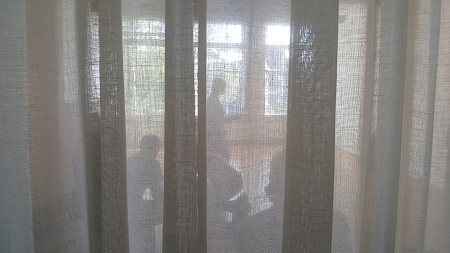
Starting point:
THE INVITED ARTISTS BRING SEVERAL WORKS TO THE PROJECT-SPACE AND BUILD UP AN EXHIBITION TOGETHER. A CONVERSATION ABOUT AUTHORSHIP WILL START WHILE MAKING THE EXHIBITION. THIS WILL BE RECORDED AND SHARED DURING THE OPENING. THEREFORE THE PROJECT WILL GIVE THE VISITORS A CLOSER INSIGHT INTO THE PROCESS AND THOUGHTS OF THE ARTISTS.
INITIATED BY MAUD OONK
SPACE-PROJECTS ‘the orchid and the wasp’
COLLABORATION WITH: PIM KERSTEN
DE HUISKAMER FENNEKE VOORSLUIS
Notes will be created by Alina Lupu
works:
GIORGOS KONTIS, Untitled, encaustic on muslin, 2017
PIM KERSTEN, Full stop, Oil paint on linen on panel, 2017
GINO BOSA, Oceanble brown part 1, adhesive paper, spray paint on wood, 2016
MARIJE GERTENBACH, The body embedded, silicate paint and sand on wood, 2016
STEPHANE VERVAEKE, Too far / Too close, textile, 2017
SANDRA LANE, Temper, foam tubes, wire, flocking powder, 2017
Notes:
We shall take turns.
I’m next:
For this exhibition, I decided to bring 3 really new pieces. They are more or less in between paintings and objects. The shapes are extractions from brackets, as known from language. I wanted to use that shape in order to form, I liked the idea of using, if you use brackets, to already existing texts like you’re always making additions with your work to an already existing context that way you create your own space within an already existing space. I also wanted to do something with the idea of a copy.
You have one object which is physically standing in space, it’s more present, and then there’s the painting. Then there’s the third panel, this to me raises questions about the physicality and nonphysically and materiality of the object if you’ll look at it later you’ll also guess some marks within the artworks.
I’ve brought these so that we can… at first, I meant them as an installation, but I'd really like to use them as brackets. If we put works between them, there are works created in between the bracket spaces. My work involves literary extractions of symbols and language, the space around it is materialized. I would love to use it as an end work in the direction of arrangement within the exhibition space. Is it possible that that work comes in between the brackets? It always depends on the other works. If we look at all the other works the work will arrange itself.
Instead of being at the beginning or at the end it can be a dot in between an abstract narrative with neither beginning nor end.
I really like the idea of the dot and reference of language. They make an interval. They convey something within something else. It’s a space within a space and I’m curious to see how this shall function in the exhibition in general and how it can be used in a non-2 dimensional space.
At the moment nobody else’s work is out and the brackets will get a whole new meaning once the works are out, especially when you unwrap them. They’re also painted in a special way. They’re painted in egg-tempera, a real fundamental and abstract artificial symbol.
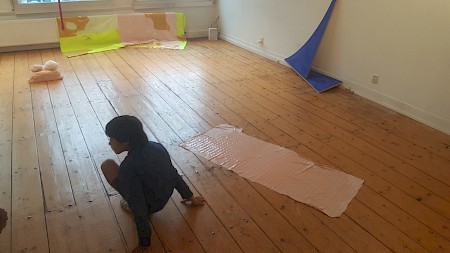
We shall take turns.
I’m next:
I’ve brought a suitcase containing a variety of things. Some of them are sculptures. A couple of things I’ve made in the last couple of days. Some are a reference to the body. Others reference the body in an abstract way. I’ve also brought materials in response to what’s going on in this room. 1 or 2 things are stand-alone, others are in relation. What I’ve brought is extremely flexible.
Do you want me to describe the actual objects? They’re in my yellow suitcase.
I will take some of the plastic out.
What material is that? Muslin, which I’ve sewed, then I’ve covered them in house paint.
I like this one, here. What material is that? Plasticine!
And here? Plaster, baking soda, and then that one is the same but wrapped in plastic.
And that? Carded’s sheep’s fleece. Brushed and brushed.
I put this, but I’m going to take it, It’s been painted onto some carpet underlay, it’s latex, so I’m going to peel it off, it’s quite long.
Self-portraits? Yes! No. I don’t know whether they are or not. Maybe. Always. Maybe.
More plasticine here.
Are they all connected to each other? Are they a series? Do they need to be exhibited all together? I’ll decide what I install, but it shall be decided in relation to everyone else’s work. Now and then I have a design idea, but quite often it’s discovered while doing it. I'll put a lot out and take a lot away.
Did you give them titles already? No. I’ll title the today.
That small thing, the plaster one, is called “measured". But nothing else at the moment.
This is ceramics. Yeah.
It’s beautiful.
I’ve got more small things. And then I have a thread and things in my bag. That’s just material. And there’s also another material that could also be a part of it, but I think I’ll get them out in response to what others are doing.
Oh, and I’ve got these as well. It’s 3d printed gloves.
And that’s it, really.
And those you need to place. Yes, there’s one way that they could hang, they could just go form the ceiling, or they could lie over other things. They can touch the floor or not. Can you put the foam tubes in them? No, I was going to leave it at home, but I just take it because it will help pad things up. I’ll just take it, in case.
Any particular reason you made the gloves? Are you interested in them as a form? It was because I was making something in a really wonderful color of red and I took them to the window and the window had other elements on it and I saw it as a painting. Those are the least as my work.
The gloves come always as a reference to a hand, to someone’s hand and they are also used in philosophy in theory, in regards to questions about the author, so whatever we might be saying about the author or the text and about the maker it’s always the hands that are the ones that...
For me, it’s always a nostalgic image to see the hands. They’re really symbolic of the author. And you were wearing them. You made them negative.
I’ve been making ceramic shoes. They were heavy but too delicate to bring. Maybe they were sort of in place of that.
They’re also like hands in the process of becoming something else like they are morphing.
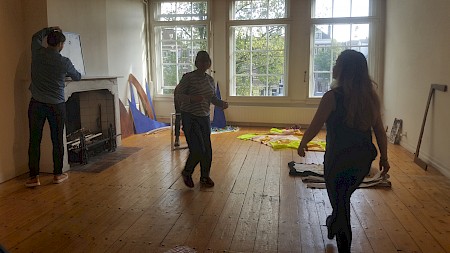
We shall take turns.
I’m next:
I’ve brought some textile collages. First I made drawings by cutting a lot and pasting them somewhere else. I like to work more 3 dimensional so not on paper, but away from the wall. In that way, I decided to work with textile so I could hang the collages in space. There was always a discussion about the status of the work because I’ve always been asked what are they really - are they a carpet, a curtain, an art object. For me, they are not functional at all. I think a lot of my practice is about creating structure in a very chaotic world.
That’s one of the collages I’ve made. This one you can hang on the ceiling or put on the floor. I use a lot of coincidence in my work. I try to combine concrete action and coincidence. For me, textile is very important because I associate it with protection. I also associate it with the opposite of protection. For me both come together you have also the other side, the dark side. You see both sides at the same time. There are is not contrast anymore.
For me in my world, in my work, that’s important. I also had a more female one. It’s in two parts. Because I come off out of the wall I try to work with an outside and an inside or a front and back, you can really walk around it. Here I thought more about how it is to walk around it or to go through it because you can also turn this other piece around. I think this side is the best but I try to work on both sides.
Would you also allow yourself to flip one side over? To show the back and the front?
Yes, they tried to push me in a very free way of presenting because I often heard that my work has a lot of freedom and experimental aspects. They find I show it in a very classical way, so they try to push me to present it in more experimental ways. I think such a way of presenting fits well with my way of working, but I have to work on it more.
People told me that my work is very happy. I was always a bit hurt then. It has a lot to do with the contrast between inner and outside. I also make landscapes with broken plaster. When I have better transport I bring them together. The broken pieces are not with me at the moment. With these pieces, I also try to create some sort of landscape. I can show you some pictures later.
I have some things to maybe hang them or I don’t know.
This is more part of something else. I also work with dead trees. I go to parks and put them in my car. I like to give them new life, new energy. This was a piece that was hanging on a tree, that I made by myself. These two are more domestic. I used a textile technique of printing with ink. I made drawings with ink then pressed it on canvas. Chaos is an important element in my work, but I try to oversee it.
That’s another one, but it’s more just like a window. It’s softer. The textile is also very soft.
That’s just a textile I’ll use a lot.
It was an adventure to take the space of my work. For me, it was a big step.
These works are just a part of my work. If you see them like facades for me it's also OK.
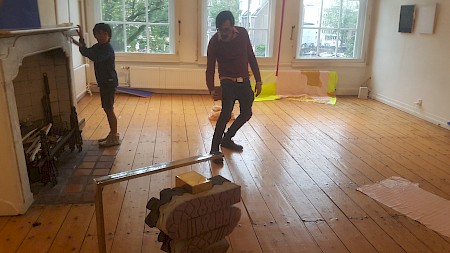
We shall take turns.
I’m next:
I lay the paintings on the wall. These are three of my recent works in the last months. It’s a new series that started something like a year ago. I’m questioning what have been the events of the recent months. In these works, I try to allow things to happen themselves. I try to not control things too much also because of my fascination with painting, I might be contriving things too much or directing things too much. Language can never truly take things over completely. It can only manipulate the situation. What occurred through that is more of a playfulness in my work, transformations, different sizes, different materials, also found objects, different materials. I’ve started using muslin, related to the transparency of the events. In the sense of the shape of a body that it takes through these transparencies. Also, the decision to take something from my studio and presenting it as an image. I used a leftover of muslin as a towel and I thought that’s an interesting image, it’s an interesting painting so I cropped it by framing it on the canvas. For me, this comes with a decision of naming it a painting. It’s also with this image which I stitched to become a painting, but then I decided to leave it as it is, with these shapes coming through.
It’s an image which is both hidden and present, a stretched canvas, an image which is not flat. The materials I use is encaustic. Pigment or oil paint with wax. I’m using wax because of the tactility, because of the fact that it feels natural, organic, it reacts to the light in a way. When you use a lot of it it gives you the feeling that you’re concealing something. And then I’m interested in the dialogue that’s happening with the transparency here.
This is also not a properly stretched canvas. It’s not completely flat. It’s a wall piece. It starts becoming like a skin, like a tissue. The image becomes the body, the body becomes the image. I’ve painted it on stretchers, then taken it off the stretcher, repainted it, then putting it back on again. There’s a play between the image and the stretcher. I thought of bringing the middle one, exactly because of the decision of picking it up and saying it’s a work.
I am interested in the authorial decision.
I’m also interested in the unpainted painting.
Of the painting that was taken, painted, repainted, on one or the other part, then transformed.
You show the material as you have found it. That’s not about your actions, or your guesses, or your individual choices, but you make some choices as well.
We shall take turns.
I’m next:
I’m looking for some scissors. It’s almost a performance to open up my work.
It didn’t even break in the transport. It’s beautiful, huh?
This is a normal picture I made. The work summaries the history of art, how we elaborate it, how we now feel it and see it.
Which history of art? The entire history of art.
I don’t have a very big consideration for ideas in art. Especially now.
I look at myself as a worker in the visual sphere. To create a visual power in a manner from time to time, even banal, you can use anything, objects that you find anywhere. I can’t speak only about one work and make a difference between that and another work because they are all part of a general idea, they are part of a general image that we see, understand and see things. Perception, exactly.
Everything is a caricature of itself. But in all of this mess new visual perceptions can come about.
For me making a work is always a struggle between what I’d like to do and what I could do. I try to take it very easy. I consider myself a little part of this entire experience. Serious things can emerge.
You can't-do anything without having the perception of chaos.
It’s precarious.
There’s also another issue consisting in my hedonistic, aesthetic way of making my work. I don’t have a very rigorous way of working. I have an aesthetical instinct that can then be translated in various philosophical aspects.
What really counts for me now that I’m getting old is other people. Art allows us to learn how to see, which is what is really important. And how to think through materials.
I start from the history of art. What used to be considered the avant-guard, now are just attempts to create visual shocks which put us in communication. This is the social aspect of art today.
Serious humor.
Formal humorism though material.
If you lose the key in the garden search in the garage.
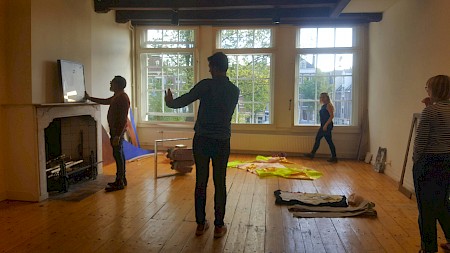
We shall take turns.
I’m next:
The drawing doesn’t need to be the endpoint, but the starting point of the installation. I think space is the most important factor in the work. Everything is possible actually.
It could be on the floor, it could be...
It’s nice to see what your first intuitive response would be when confronted with the elements.
Space comes first and then the elements.
You can always call me again.